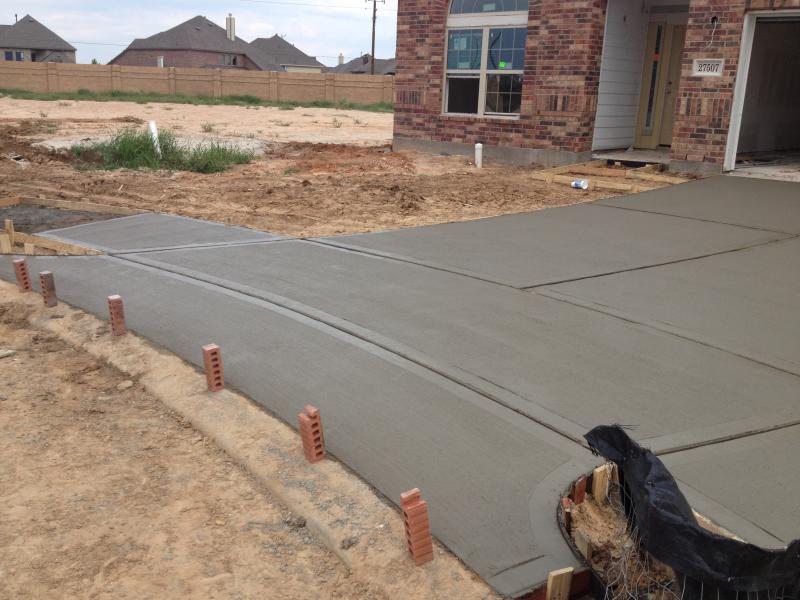Missing Expansion Joints in Driveway
Builder just poured my driveway, but only put expansion joints half way down the driveway and stopped at the sidewalk. It’s already been 48 hours since the pour so I’m assuming it is too late to do anything about this without ripping it up.
My neighbors who have contracted with another builder put expansion joints all the way down to the street.
Is this worth raising to the builder for corrective action? Or should I not be worried about this?
Thanks,
Drew























Replies
Expansion Joints or control joints?
An expansion joint would have some type of non rigid material in it such as tar impregnated fiber board and I typically only see it around here between the drive and garage slab and the drive and the joint with curb. If you don't have expansion joints there, it could be a big issue.
The rest of the time, all I see are control joints which are simply areas weakened in the hope that the concrete will crack there instead of randomly. Make no mistake it will crack and the desire is that the crack is in the control joints.
What you have for control joints look great. In fact, most drives I see now don't have control joints like that anymore. They pour the slab in one monolithic piece and only finish the sides like yours with an edging tool and then they come back later with a dry saw and cut control joints. The only part I would question is the sidewalk portion and the apron along the road. You MIGHT want them to cut them in half with a saw because they may crack across the narrow width anyway but it won't match the finish edge of the other joint up the middle of the driveway (will still be just as functional). Other than that, the job you got is better than what you see in most areas (as far as finish and control joints)
Actually, the job's pretty sloppy compared to what I used to see as a kid -- you shouldn't see the tool marks like that. But in terms of control joints it's pretty good, and probably about the best you can hope for anymore.
But as you say, the sidewalk and apron will most certainly crack, and it would be wise to go ahead and put in saw-cut control joints for those.
Thanks for your responses, Yes those are expansion joints you see in the middle of the driveway but I was interested to know that over time driveways will crack regardless so I'm less concerned now about the sidewalk and apron.
I'll be asking the builder if it's not too late to saw in control joints at the sidewalk.
-Drew
You are probably ok.
Joint spacing is a function of the concrete strength and the thickness, and can vary depending on how many degrees of seasonal temperature difference seen in the climate.
A typical 4-inch sidewalk has control joints every five feet, a six inch driveway only needs them at twenty to twenty-five feet.
A typical sidwalk only has an expansion joint every fifth or six panel, which is twenty-five to thirty feet, depending on the temperature extremes. Residential driveways are typically installed with expansion joints every twenty to twenty five feet. But, I have seen commercial driveways that only had expansion joints at edges or forty feet wing to wing.
The place I'd be concerned about not having an expansion joint would be between the garage slab, and the driveway.
There is probably either a standard plan at the city/county that covers this, or there is one designed and sealed by an engineer.
If you have building inspection department, they should be checking the construction against the approved plans, and requiring the contractor to replace the work if it does not comply to the plans.
Control joints can be cut at any time -- years later if desired. It's easier to cut them when the concrete is still "green", but not that much harder when it's cured.
Control Joints are worthless once green cure occurs.
The purpose of control joints is to weaken the plane of the concrete, so that it cracks in a predicatable manner. The spacing is dependant on the depth of the slab, and the tensile strength of the concrete. The tensile strength is normally estimated from the 28-day compressive strength rather than measured directly.
When concrete is initially curing the heat of hydration brings the temperature up and the slab is in an expanded state relative to it's surroundings.
After 24 to 48-hours (depending on the water cement ratio, the type of portland cement, the type of admixtures, and sack content of the mix design), the heat of hydration rapidly drops off. The concrete develops tensile strength considerably slower than it does compressive strength. The control joints need to be in place before the heat of hydration decreases and the slab starts to contract, to do what they are intended to do and control the location of the tension cracking.
That is a beautiful job. If I had done it, I would be proud, and if you then questioned me about it,I would consider you a crazy man.
Except that, in 5 years, there will be a nasty crack down the center of the sidewalk and apron.